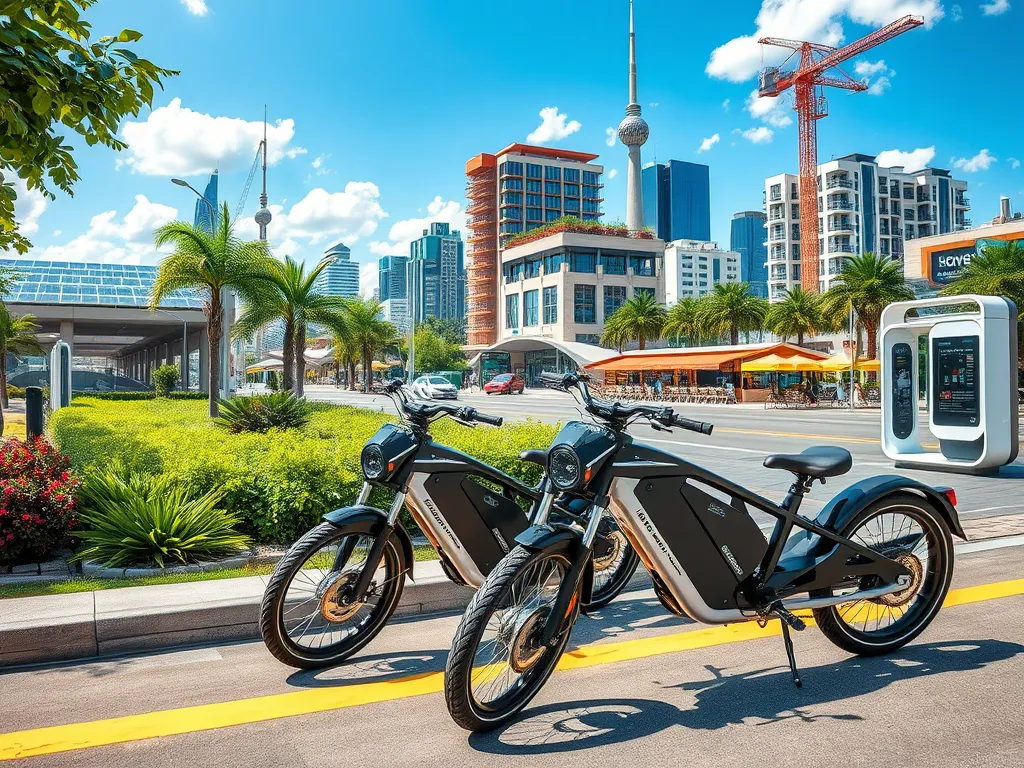Understanding E-Bike Technology: Innovations and Advancements
E-Bike Technology has revolutionized the way we perceive urban mobility and personal transportation. Combining traditional biking with electric propulsion, e-bikes offer an eco-friendly alternative for commuting and leisurely rides. With the advancement of battery technology, motor efficiency, and smart features, E-Bike Technology is becoming increasingly popular among commuters and cycling enthusiasts alike. This article delves into the various aspects of E-Bike Technology, highlighting innovations, performance features, safety technologies, sustainable practices, and exciting accessories.
At the core of E-Bike Technology is the integration of electric motors, batteries, and computer systems that provide enhanced riding experiences. Modern e-bikes come equipped with lightweight materials, powerful electric motors, and high-capacity batteries, enabling riders to travel longer distances with less physical exertion. The appeal of e-bikes extends beyond their physical capabilities—they embody a movement toward sustainable transportation, reducing reliance on fossil fuels and minimizing carbon footprints.
Moreover, E-Bike Technology is being enriched with advancements in smart systems and connectivity. Many e-bikes now feature built-in navigation systems, Bluetooth connectivity for smartphones, and even integration with applications that allow riders to track their performance and routes. This influx of technology enhances not only the riding experience but also the overall usability of e-bikes in daily commutes and recreational activities.
As the demand for e-bikes continues to surge, manufacturers are focusing on improving their performance features as well. Innovations such as advanced battery management systems, regenerative braking, and customizable power settings aim to maximize efficiency and adaptability. The ongoing evolution of E-Bike Technology not only caters to individual needs but also addresses the growing concerns for smarter and greener transportation solutions.
In conclusion, E-Bike Technology is at the forefront of changing how we navigate our world. As technology advances, e-bikes will likely become a standard for urban travel, encouraging a healthier population and a cleaner environment. This article explores the latest innovations in e-bikes, their performance capabilities, safety technologies, sustainability in manufacturing, and compelling accessories.
Latest E-Bike Innovations
One of the most exciting developments in E-Bike Technology is the introduction of smart e-bike systems that enhance navigation. These systems utilize GPS and app-based technologies to provide riders with real-time information about their routes, traffic conditions, and even suggests alternate paths to optimize their journeys. Riders can effortlessly track their rides, distances, and battery usage while enjoying a more connected and informative riding experience.
Battery technology continues to evolve with innovations focusing on range and charging efficiency. Current advancements include high-capacity lithium-ion batteries, fast-charging solutions, and the development of lightweight materials that enhance battery efficiency. These improvements allow e-bike riders to travel longer distances without worrying about depleting their battery while reducing charging times, making e-bikes an even more appealing choice.
Integrating solar power with E-Bike Technology is another groundbreaking innovation. Some manufacturers are exploring solar panels that can be affixed to e-bikes or built into their frames, enabling the generation of clean energy on-the-go. This sustainable energy source can supplement the electric battery, making e-bikes more self-sufficient and environmentally friendly.
AI-powered ride assistance features are revolutionizing the user experience in E-Bike Technology. Intelligent systems can analyze riding patterns, terrain conditions, and rider preferences to adjust assist levels, optimize performance, and even anticipate upcoming challenges like hills or obstacles. This level of personalization enhances both safety and enjoyment for the rider.
E-Bike Performance Features
Motor power options in e-bikes are crucial for determining their overall performance. Understanding watts and torque can help potential buyers select the right e-bike for their needs. Generally, more watts translate to a higher maximum speed and efficiency, while higher torque enables better acceleration and handling, especially on inclines. Manufacturers now offer a range of motor options to suit commuter needs, recreational riders, and even off-road enthusiasts.
Suspension systems have become a vital component in the design of e-bikes, offering enhanced comfort and control. Advanced suspension designs enable riders to tackle rough terrains with ease while reducing fatigue on longer rides. Features like adjustable front forks or full-suspension setups provide a tailored riding experience, allowing riders to enjoy smooth and stable journeys regardless of the road conditions.
Tire technology has also progressed significantly over recent years, focusing on grip and durability. Many e-bike manufacturers incorporate puncture-resistant tires with optimized tread patterns for enhanced traction. This innovation not only improves safety and performance but also prolongs tire life, making e-bikes a more cost-effective choice for many riders.
Weight distribution plays a crucial role in the performance of e-bikes. Properly balanced weight ensures better handling, stability, and overall riding experience. Manufacturers are meticulously designing e-bikes with central battery placements and strategic component layouts to enhance weight distribution, resulting in more agile and responsive rides.
E-Bike Safety Technologies
Anti-lock braking systems (ABS) in e-bikes serve as a critical safety feature, preventing wheel lock-up during sudden braking situations. This technology improves control and stops stability, allowing riders to maintain steering during emergency stops. ABS has become a common addition to high-performance e-bikes, assuring riders of higher safety levels.
Integrated GPS systems in e-bikes not only assist riders during navigation but also serve as a deterrent for theft. These systems can track the bike's location in real-time, enabling owners to monitor their e-bikes and assist law enforcement in recovering stolen units. Such smart technologies significantly enhance the security of e-bikes and provide peace of mind for riders.
Smart helmets equipped with communication features are emerging as essential safety accessories for e-bike riders. These helmets often integrate Bluetooth connectivity for hands-free communication, built-in speakers for navigation prompts, and even augmented reality displays for enhanced situational awareness. This fusion of technology and safety helps riders stay connected while ensuring their focus remains on the road.
Lighting innovations are essential for improving visibility during night riding. Advanced LED lighting systems enhance brightness and reduce power consumption while offering various modes and intensities. This technology ensures that e-bike riders remain visible to other road users and can enjoy safer rides in low-light conditions.
Sustainable Practices in E-Bike Manufacturing
Sustainability is a growing focus in E-Bike Technology, with manufacturers increasingly adopting eco-friendly materials in their production processes. Companies are investing in recyclable aluminum and composites, reducing their environmental impact while creating robust e-bikes that are both lightweight and durable.
Understanding the life cycle of e-bike batteries is crucial for sustainability. Manufacturers are developing batteries that not only have longer lifespans but also contain fewer harmful substances. Many companies are now opting for modular battery designs that allow for easier replacements, reducing electronic waste and fostering a more sustainable future for e-bikes.
Recycling standards for e-bike components are becoming essential as the number of e-bikes on the road grows. Manufacturers are establishing systems to ensure that old and damaged parts can be recycled responsibly, minimizing waste and pushing for a circular economy within the industry. Collaborations with recycling organizations help facilitate these practices.
Sourcing renewable materials in e-bike manufacturing reinforces the commitment to sustainability. By using materials from renewable sources, such as bio-based plastics and sustainably harvested woods for components, manufacturers can dramatically reduce their ecological footprints and meet the growing consumer demand for environmentally conscious products.
E-Bike Accessories and Enhancements
Smartphone integration has become a game-changer for e-bike users, with many bikes now offering dedicated companion apps. These apps can track various metrics such as ride distance, speed, battery life, and even maintenance alerts. Some apps allow for route planning and syncing with other riders, enriching the biking experience.
Customizable lighting and horn systems enhance the safety and personalization of e-bikes. Riders can now choose from a variety of lighting options, including color, intensity, and flashing patterns, while integrated horn systems offer varying levels of sound, allowing riders to alert others while fitting their personal style.
For commuters, additional storage solutions have become essential. Many e-bikes come equipped with built-in racks, basket options, and even saddlebags tailored to fit seamlessly onto e-bike frames. These enhancements enable riders to carry their belongings more efficiently, making e-bikes a practical choice for daily commutes.
Upgrading with performance parts has become increasingly popular among e-bike owners, allowing them to enhance specific aspects of their bikes. From higher-capacity batteries and advanced motors to better braking systems and suspension components, customization options empower riders to tailor their e-bikes to match their unique riding preferences.


